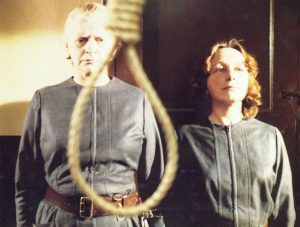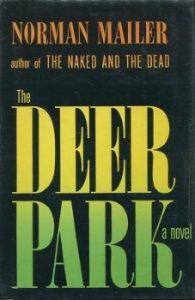
© Peter Walker (Heritage) Ltd
Every year, March is designated ‘Women in Horror Month’. This is when fans of horror fiction, cinema, television, comics, games, etc., are encouraged “to learn about and showcase the underrepresented work of women in the horror industries. Whether they are on the screen, behind the scenes, or contributing in their other various artistic ways, it is clear that women love, appreciate, and contribute to the horror genre.”
As an occasional writer of horror fiction, and just before the month ends, here’s my contribution. I pay tribute to a lady who, during a unique run of movies, did much to give me nightmares – or indeed, frightmares – during my impressionable youth.
Scottish actress Sheila Keith had a remarkable dual career. Though not a household name, she was certainly a familiar face – with a familiar, haughty, often-disapproving voice – to a couple of generations of British TV viewers. This was because of her appearances as prim ladies of a certain age, frequently nuns, or aristocrats with double-barrelled names, in cosy situation comedies like The Liver Birds (1969-78), Some Mothers do ‘Ave ‘Em (1973-78), Rings on their Fingers (1978-80), Bless Me Father (1978-81), Agony (1979-81), The Other ‘Arf (1980-84), Never The Twain (1981-91), A Fine Romance (1981-84) and The Brittas Empire (1991-97).
On top of that, she put in time in ITV’s long-running but much-derided soap opera Crossroads (1964-88), where she played cook Betty Cornet, toiling in the Crossroads Motel kitchen for 31 episodes in 1967. Poor Betty perished when workmen extending the motel’s premises accidently uncovered and set off a World War II bomb.
The second, less conventional strand of Keith’s resumé came from her involvement in a series of movies made by British director Pete Walker. Having started off making sex-comedies like 1969’s School for Sex and 1970’s Cool It Carol!, Walker hit his stride making horror movies during the 1970s, with Keith as a regular collaborator. A combination of exploitation cinema and social commentary, these were memorably grim – serving up (for the time) disturbingly graphic violence, attacking institutions like the judiciary and the Catholic church, and generally showing how depressingly grotty life was in 1970s Britain. And Keith’s performances, as ladies doing unspeakable things whilst maintaining the veneer of snootiness that’d served her well in her TV sitcom work, made the films even more memorable.
The first Keith-Walker collaboration was 1974’s House of Whipcord (1974), wherein a young woman called Ann-Marie (Penny Irving) suffers some spectacularly bad luck. Firstly, she discovers that a nude photograph of her has been put on public display. Then the nice young man who befriends her (Robert Tayman, who’d recently played the villain in the 1971 Hammer horror flick Vampire Circus), and takes her to his country estate to escape the scandal, turns out to be a ‘honey-trap‘. His parents are a demented anti-permissive-society campaigner called Margaret Wakehurst (Barbara Markham) and a reactionary, but now blind and senile judge called Justice Bailey (Patrick Barr). They’ve turned the country house into a secret, illegal prison where women they deem to have ‘fallen’ are brutally punished. And Ann-Marie, they’ve decided, has fallen.

© Peter Walker (Heritage) Ltd
The remainder of the film is basically a race against time, with Ann-Marie’s friends (Ray Brooks and Ann Michelle) trying to track her down and rescue her, before her repeated attempts to escape the prison incur the ultimate penalty – execution. You might not want to bet your life savings on there being a happy ending.
Though not the lead villainess, Keith is memorable as Walker, one of Wakehurst and Bailey’s prison wardens. Walker may not be doing the job just for the money and from a misguided sense of justice — seeing the young inmates flogged seems to turn her on. Meanwhile, the other Walker, Pete, and his scriptwriter David McGillivray make it clear who their target is in a sarcastic opening-credits statement: “This film is dedicated to those who are disturbed by today’s lax moral codes and who eagerly await the return of corporal and capital punishment…” They may have had in mind the Nationwide Festival of Light, in vogue at the time, described by Wikipedia as a ‘grassroots movement formed by British Christians concerned about the rise of the permissive society and social changes in English society by the late 1960s’ and whose supporters included Lord Longford, Malcolm Muggeridge, Cliff Richard and the inevitable Mary Whitehouse.
A year later, Keith got a bigger role in House of Mortal Sin (1975), which this time took a swipe at organised religion and the Catholic church in particular. This had a slightly starrier cast too. Stephanie Beacham and Susan Penhaligon play Vanessa and Jenny, sisters who, through their friendship with a well-meaning young priest (Norman Eshley, later to find fame as snobby neighbour Jeffrey Fourmile in the 1976-79 TV sitcom George and Mildred), unwittingly enter the orbit of the deranged Father Xavier Meldrum (Anthony Sharp). Not only is Meldrum a stalker who’s soon targeting Jenny, but he’s a homicidal maniac who uses some appropriately ecclesiastical methods to murder people – bludgeoning them with incense-burners, feeding them poisonous communion wafers, throttling them with rosary beads.
Keith plays Meldrum’s housekeeper Miss Brabazon, who turns a blind eye – literally a blind eye, because she’s missing one – to the old monster’s crimes due to her love for him. She has responsibility for looking after Meldrum’s extremely elderly and ailing mother, and particularly gruelling are the scenes where she abuses her charge, blaming her for making her son enter the priesthood and a lifetime of celibacy. Again, don’t expect a happy ending.

© Peter Walker (Heritage) Ltd / Columbia Pictures
However, it’s the film Keith made for Walker between the two Houses, Whipcord and Mortal Sin, that saw her at her terrifying best. In Frightmare (1974), she plays Dorothy Yates, a character who spends the film shifting gears between being a confused, pathetic, middle-aged housewife and a demented brain-eating cannibal. In the late 1950s Dorothy and her husband Edmund (Rupert Davies) were placed in an asylum after a string of murders – though innocent, such was Edmund’s love for Dorothy that he allowed himself to be incarcerated alongside her. Dorothy’s last 1950s victim, incidentally, is played by Andrew Sachs, soon to become a star as Manuel, John Cleese’s Spanish waiter / punchbag in Fawlty Towers (1975-79).
Released from the mental institution in the mid-1970s, the couple become a headache for Jackie (Deborah Fairfax), Edmund’s daughter from a previous marriage. She has to supply her father and stepmum, who’ve holed up in a remote farmhouse, with parcels of sheep’s brains in an attempt to satisfy Dorothy’s cravings. Also, she’s keen to keep her tearaway half-sister Debbie (Kim Butcher), Edmund and Dorothy’s daughter, away from her parents for obvious reasons. Things don’t work out well. Dorothy is soon demanding brains of the human variety, lures people into her parlour (full of chintzy ornaments and cups of tea) for Tarot card readings, kills them and eats them. Meanwhile, there are disturbing signs that her cannibalistic urges may be running in the family.
Frightmare climaxes with some nasty stuff involving a Black-and-Decker drill, but nothing quite compares to the image of Dorothy that assails Jackie during a dream – her mad stepmother stalks up to her, white-faced and grinning, chewing brains from a red-soaked parcel, blood oozing down her chin. In its less sensational, buttoned-up way, Frightmare is the English Home Counties’ answer to The Texas Chainsaw Massacre, which was released the same year.

© Peter Walker (Heritage) Ltd / Lone Star Pictures
Walker cast her in two later horror movies, 1978’s The Comeback and 1982’s House of the Long Shadows, but neither was to the standard of their earlier work. The Comeback has an interesting idea – an elderly couple (one of whom is Keith) take gruesome revenge on a faded rock star whom they believe induced their daughter to commit suicide. Confronting the rocker at the end, Keith admonishes him in a hate-filled voice for his decadence, his depravity and even his ‘foul contortions’ onstage. This would have worked if the rock star had been played by someone properly decadent like Mick Jagger or Iggy Pop but, laughably, he’s played by Jack Jones, housewives’ favourite and singer of the Love Boat theme (1977). Jones’s performance was likened by one critic to that of a ‘hibernating bear’.
Some of the other casting is distracting too. Jones’s manager is played by David Doyle, who at the time was a regular in the popular American TV show Charlie’s Angels (1976-81) – wow, I thought the moment he appeared, it’s Bosley! Meanwhile, in the role of Keith’s husband is Bill Owen, famous in Britain for playing the wellie-wearing, ferret-loving Compo in the BBC’s Last of the Summer Wine, which ran from 1973 to 2010 and became the longest-running TV sitcom in the world. Just to round out the weirdness of The Comeback’s cast, Jack Jones, Bosley and Compo are joined by Pamela Stephenson, soon to hit it big as a comedienne in the BBC’s satirical sketch-show Not the Nine O’Clock News (1979-82).
You couldn’t nitpick about the cast of House of the Long Shadows, the last of Keith and Walker’s movies and, indeed, the last film Walker made. For horror fans, it’s awesome – horror legends Vincent Price, Christopher Lee, Peter Cushing and (from an earlier period of macabre cinema) John Carradine. Long Shadows tells the story of a hotshot young author (Desi Arnaz Jr) who makes a bet with his publisher (Richard Todd) that he can write a novel in 24 hours in a suitably-inspiring environment – a creepy, deserted mansion house in Wales. However, Arnaz Jr soon discovers that the mansion isn’t deserted at all. It’s still home to a decrepit lord (Carradine) and his sons (Price and Cushing) and daughter (Keith). Complicating matters is Lee as a pompous businessman, turning up to declare his intention to buy the property, and then the revelation that there’s a madman on the loose, killing the house’s occupants one by one.
House of the Long Shadows is a disappointment, which is hardly a surprise considering the disparate elements involved in its making. Price, Lee and Cushing had become stars in the 1950s and 1960s working for studios like Hammer Films and American International Pictures, making films that were colourful, gothic-horror costume-dramas – for example, instalments in the studios’ Dracula, Frankenstein and Edgar Allan Poe series. Made later, in the 1970s, Walker’s brutal, contemporary-set horror films were obviously a reaction against these. Similarly, his scriptwriter here, Michael Armstrong, had directed gory films like The Haunted House of Horror (1969) and Mark of the Devil (1970), which definitely weren’t of the gothic fairy-tale school either. Armstrong’s script, though, was based on a very old novel and play, Seven Keys to Baldpate, both from 1913. And the producers were none other than Menahem Golan and Yoram Globus of that very 1980s-esque outfit, Cannon Films. Thus, the stars, the director and scriptwriter, the source material and the producers belonged to wildly-different eras. Long Shadows unsurprisingly doesn’t gel.

© Cannon Film Distributors
It doesn’t help that Armstrong’s script ends with a couple of twists that don’t so much amaze the audience with their cleverness as make them groan at their corniness. But still, it’s a pleasure to see Price, Lee, Cushing and Carradine together, and Keith has fun playing an eccentric who fancies herself as a singer, even though she’s painfully tone-deaf. Small wonder she’s eventually done in with a length of piano wire.
Thereafter, Keith’s film appearances were few, although she turned up in the 1986 John Cleese movie Clockwise. She also kept busy into the 1990s with TV appearances. Fittingly, her last role – three years before her death in 2004 – was in an episode of the 2001 spoof anthology show Dr Terrible’s House of Horrible, written by Graham Duff and Steve Coogan and designed as an affectionate piss-take of old British horror movies from the 1950s, 1960s and 1970s. Though handsomely staged, it wasn’t particularly good. However, it was nice to see Keith appear in an episode called And Now the Fearing…, playing a gypsy woman who crosses swords with an architect (Alexander Armstrong) who wants to clear her encampment to make way for a new development. Keith, predictably, draws on some old gypsy magic and has fun turning the tables on the smug, smarmy Armstrong.
The actresses who found fame in British horror movies tended to be of the young, sexy, ‘starlet’ variety – Ingrid Pitt, Caroline Munro, Linda Hayden and so on. Sheila Keith was already in her fifties when she arrived on the scene and didn’t have youth or sexiness on her side. Rather, splendidly playing a succession of harridans who were psychotic, sadistic, embittered and / or pitiful, she represented grey power. With power tools.

© Peter Walker (Heritage) Ltd







